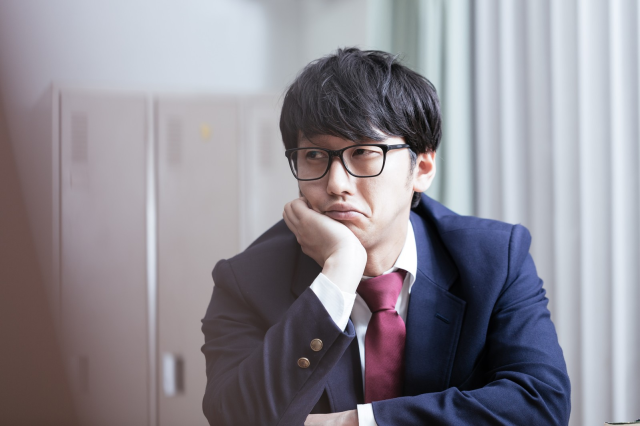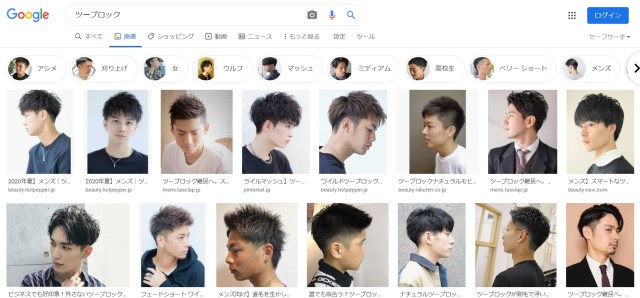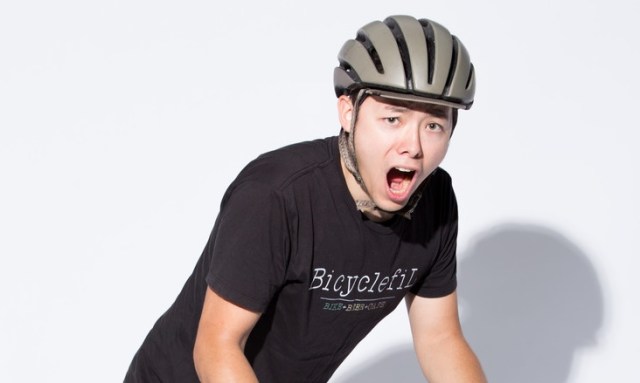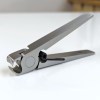
Apparently the two block hairstyle is too dangerous for kids to have.
Japan has a lot of school rules that don’t make a lot of sense. While exact regulations vary by specific school, some of the more frustrating ones we’ve examined include “students must participate in extracurricular activities,” “girls must not wear tights,” and “students’ underwear must be white.”
Today, though, let’s talk about a head-related head-scratcher: Tokyo public high schools not allowing students to have what’s known in Japanese as a “two block” hairstyle. In simple terms, it’s a style where the har is trimmed short at the sides and back, but left long on top.
▼ Japanese Google search results for “two block”
At a meeting of the Tokyo Metropolitan Assembly (Tokyo’s city council equivalent), assemblyman Yuichi Ikegawa, a member of the Japanese Communist Party representing a district of Tokyo’s Machida City, wanted to know why the two block hairstyle is prohibited, and got a very surprising answer, as shown in the video below.
▼ The meeting took place in March, but Ikegawa only recently posted the video through his Twitter account.
都立高校の校則。
— 池川友一 Yuichi Ikegawa (@u1_ikegawa) July 13, 2020
なんでツーブロックはダメなのか。
本当に驚愕の答弁。pic.twitter.com/Wj2JhIchEu
As the video opens, the 35-year-old Ikegawa, wearing a gray suit and blue tie, stands up and poses his question.
“I have heard from so many students that, when they ask why the two block hairstyle is not allowed, they are stubbornly told ‘Because that’s the rule’ or ‘Those are the school regulations.’
So why is it not allowed?”
We then see Yuji Fujita, the head of the Tokyo Metropolitan Board of Education, standing at a podium to give his response. The video jumps a few times as he starts speaking, but shows him saying:
“In regards to the hairstyle you mention…there are cases of students being involved in incidents or getting into accidents as a result of their appearance, and so the rule is something that has been put in place with the objective of protecting the students.”
▼ But wouldn’t it be even safer to give all the kids helmets, to cushion them against impacts and hide any dangerous haircuts?
It’s worth noting that in Japanese, the term jiken (“incident”) often refers to some sort of dangerous altercation or other or other trouble with the law. After delivering his response, Fujita then swiftly leaves the podium, while Ikegawa attempts to follow up with:
“So what you’re saying just now is that if they have a two block hairstyle, there is a chance that students will be involved in incidents and accidents? If I may speak frankly, I don’t understand what you mean by that. I think that’s a surprising answer. Does any data actually exist that shows that having a two block hairstyle makes someone more likely to get into such trouble or accidents?
When kids get into trouble, the message that reaches them isn’t that there’s a problem with their hairstyle. I do not believe that schools banning two block hairstyles has any basis in societal common sense or the progression of modern times, and is simply an arbitrary requirement set by schools.”
No doubt making the two block prohibition especially frustrating for students is that it’s arguably the most popular hairstyle among Japanese teens and young adults, being featured on the heads of numerous pop idols and TV drama stars. The two block has become a common enough sight that many Twitter commenters who watched Ikegawa’s videos were also left exasperated by Fujita’s explanation.
“There’s no need to ban the two block.”
“They had this rule at the junior high I went to…It’s totally out of touch with the times.”
“Hairstyling is a form of personal expression. I think it’s unconstitutional for a school rule to impose upon the student’s freedom of expression.”
“A two block is just common sense these days. People trim their hair at the sides and back before it gets too long or hot. It’s not like 30 years ago where two blocks were only something super-fashionable Harajuku guys or punk rockers had.”
The last comment points to what might be the rationale behind the no-two-block rule. Taken in its loosest definition, a two block could also include mohawks, as well as certain types of pompadours, which also have a strong association with gangs and juvenile delinquency in Japan. Perhaps it’s that image that Fujita and others behind the ban are worried about, and they feel that two blocks are favored by youths likely to go looking for trouble and find it. Alternatively, they may also feel that boys with more modern, fashionable two blocks are concentrating more on their appearance than their studies, though that leaves the question of how that will cause them to be involved in “incidents and accidents.”
Even a few Twitter commenters to Ikegawa’s post voiced their opinions that they think a two block is unacceptable for a high schooler, so it’s unlikely that the ban will be repealed anytime soon, but at least students in Tokyo with naturaly brown hair won’t be forced to dye it black anymore.
Source: Twitter/@u1_ikegawa via Hachima Kiko
Top image: Pakutaso
Insert images: Google, Pakutaso
● Want to hear about SoraNews24’s latest articles as soon as they’re published? Follow us on Facebook and Twitter!
Follow Casey on Twitter, where he still doesn’t understand why his junior high school’s dress code bothered to ban ascots, as though anyone wanted to wear one.



 Petition to allow students to choose what they wear to school gathers almost 19,000 signatures
Petition to allow students to choose what they wear to school gathers almost 19,000 signatures Japanese junior high school girl removed for class from three days for grooming her eyebrows
Japanese junior high school girl removed for class from three days for grooming her eyebrows Japanese schoolgirl points out an especially dumb part of her school’s “no tights” dress code
Japanese schoolgirl points out an especially dumb part of her school’s “no tights” dress code Tokyo public schools will stop forcing students with non-black hair to dye it, official promises
Tokyo public schools will stop forcing students with non-black hair to dye it, official promises Students in Finland, the world’s best-educated country, react to Japan’s harsh school rules
Students in Finland, the world’s best-educated country, react to Japan’s harsh school rules Foreigner’s request for help in Tokyo makes us sad for the state of society
Foreigner’s request for help in Tokyo makes us sad for the state of society Seaside scenery, history, and so many desserts on Yokohama’s Akai Kutsu【Japan Loop Buses】
Seaside scenery, history, and so many desserts on Yokohama’s Akai Kutsu【Japan Loop Buses】 Should you add tartar sauce to Japanese curry rice? CoCo Ichi makes diners an unusual offer
Should you add tartar sauce to Japanese curry rice? CoCo Ichi makes diners an unusual offer Japanese city loses residents’ personal data, which was on paper being transported on a windy day
Japanese city loses residents’ personal data, which was on paper being transported on a windy day Harajuku Station’s beautiful old wooden building is set to return, with a new complex around it
Harajuku Station’s beautiful old wooden building is set to return, with a new complex around it Red light district sushi restaurant in Tokyo shows us just how wrong we were about it
Red light district sushi restaurant in Tokyo shows us just how wrong we were about it Osaka governor suggests lowering voting age to 0 to curb population decline
Osaka governor suggests lowering voting age to 0 to curb population decline Japanese ramen restaurants under pressure from new yen banknotes
Japanese ramen restaurants under pressure from new yen banknotes Expensive Japanese nail clippers: Are they worth it?
Expensive Japanese nail clippers: Are they worth it? Japan’s massive matcha parfait weighs 6 kilos, contains hidden surprises for anyone who eats it
Japan’s massive matcha parfait weighs 6 kilos, contains hidden surprises for anyone who eats it McDonald’s new Happy Meals offer up cute and practical Sanrio lifestyle goods
McDonald’s new Happy Meals offer up cute and practical Sanrio lifestyle goods French Fries Bread in Tokyo’s Shibuya becomes a hit on social media
French Fries Bread in Tokyo’s Shibuya becomes a hit on social media Studio Ghibli releases new action figures featuring Nausicaä of the Valley of the Wind characters
Studio Ghibli releases new action figures featuring Nausicaä of the Valley of the Wind characters New private rooms on Tokaido Shinkansen change the way we travel from Tokyo to Kyoto
New private rooms on Tokaido Shinkansen change the way we travel from Tokyo to Kyoto Tokyo Tsukiji fish market site to be redeveloped with 50,000-seat stadium, hotel, shopping center
Tokyo Tsukiji fish market site to be redeveloped with 50,000-seat stadium, hotel, shopping center Beautiful Ghibli sealing wax kits let you create accessories and elegant letter decorations【Pics】
Beautiful Ghibli sealing wax kits let you create accessories and elegant letter decorations【Pics】 Studio Ghibli releases Kiki’s Delivery Service chocolate cake pouches in Japan
Studio Ghibli releases Kiki’s Delivery Service chocolate cake pouches in Japan New definition of “Japanese whiskey” goes into effect to prevent fakes from fooling overseas buyers
New definition of “Japanese whiskey” goes into effect to prevent fakes from fooling overseas buyers Our Japanese reporter visits Costco in the U.S., finds super American and very Japanese things
Our Japanese reporter visits Costco in the U.S., finds super American and very Japanese things All-you-can-drink Starbucks and amazing views part of Tokyo’s new 170 meter-high sky lounge
All-you-can-drink Starbucks and amazing views part of Tokyo’s new 170 meter-high sky lounge More foreign tourists than ever before in history visited Japan last month
More foreign tourists than ever before in history visited Japan last month New Pokémon cakes let you eat your way through Pikachu and all the Eevee evolutions
New Pokémon cakes let you eat your way through Pikachu and all the Eevee evolutions Disney princesses get official manga makeovers for Manga Princess Cafe opening in Tokyo
Disney princesses get official manga makeovers for Manga Princess Cafe opening in Tokyo Sales of Japan’s most convenient train ticket/shopping payment cards suspended indefinitely
Sales of Japan’s most convenient train ticket/shopping payment cards suspended indefinitely Sold-out Studio Ghibli desktop humidifiers are back so Totoro can help you through the dry season
Sold-out Studio Ghibli desktop humidifiers are back so Totoro can help you through the dry season Japanese government to make first change to romanization spelling rules since the 1950s
Japanese government to make first change to romanization spelling rules since the 1950s Ghibli founders Toshio Suzuki and Hayao Miyazaki contribute to Japanese whisky Totoro label design
Ghibli founders Toshio Suzuki and Hayao Miyazaki contribute to Japanese whisky Totoro label design Doraemon found buried at sea as scene from 1993 anime becomes real life【Photos】
Doraemon found buried at sea as scene from 1993 anime becomes real life【Photos】 Tokyo’s most famous Starbucks is closed
Tokyo’s most famous Starbucks is closed One Piece characters’ nationalities revealed, but fans have mixed opinions
One Piece characters’ nationalities revealed, but fans have mixed opinions We asked a Uniqlo employee what four things we should buy and their suggestions didn’t disappoint
We asked a Uniqlo employee what four things we should buy and their suggestions didn’t disappoint Princesses, fruits, and blacksmiths: Study reveals the 30 most unusual family names in Japan
Princesses, fruits, and blacksmiths: Study reveals the 30 most unusual family names in Japan Crazy Japanese “doctor” thinks babies live in clouds, choose their mothers from the heavens
Crazy Japanese “doctor” thinks babies live in clouds, choose their mothers from the heavens “Students are only allowed three sneezes in class” Japanese people share their worst school rules
“Students are only allowed three sneezes in class” Japanese people share their worst school rules All-boys’ high school in Japan has mandatory grooming lesson, teaches about skincare, hairstyling
All-boys’ high school in Japan has mandatory grooming lesson, teaches about skincare, hairstyling Tokyo police arrest teen for having knife 2mm too long, released because type of knife mistaken
Tokyo police arrest teen for having knife 2mm too long, released because type of knife mistaken Head of kindergarten arrested for spitting on elementary students who were in his way
Head of kindergarten arrested for spitting on elementary students who were in his way Japanese McDonalds’ branch bans an entire middle school from entering the restaurant
Japanese McDonalds’ branch bans an entire middle school from entering the restaurant Manga artist wants Japanese teachers to feel, for two seconds, how dumb their girls’ dress code is
Manga artist wants Japanese teachers to feel, for two seconds, how dumb their girls’ dress code is Be kind to blind pedestrians by choosing where you step when walking through the snow in Japan
Be kind to blind pedestrians by choosing where you step when walking through the snow in Japan Tokyo junior high school demands students wear white underwear as part of dress code
Tokyo junior high school demands students wear white underwear as part of dress code Japanese high school student shows how to recreate cute hairstyle from hit anime Your Name
Japanese high school student shows how to recreate cute hairstyle from hit anime Your Name Japanese elementary school student teaches us how to solve a difficult maths problem
Japanese elementary school student teaches us how to solve a difficult maths problem Does Tokyo need a legal limit on kids’ video game playing time? Governor gives opinion
Does Tokyo need a legal limit on kids’ video game playing time? Governor gives opinion Japanese schools banning nicknames, mandating use of -san divides opinions
Japanese schools banning nicknames, mandating use of -san divides opinions Female high school students continue to be banned on baseball field at Koshien Stadium in Japan
Female high school students continue to be banned on baseball field at Koshien Stadium in Japan Japanese middle school criticized for pulling out girls’ bra straps to check their color
Japanese middle school criticized for pulling out girls’ bra straps to check their color Human pyramids continue in Kobe schools as injuries mount to 51, mayor’s pleas to stop unanswered
Human pyramids continue in Kobe schools as injuries mount to 51, mayor’s pleas to stop unanswered
Leave a Reply